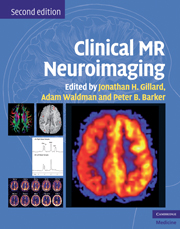Book contents
- Frontmatter
- Contents
- Contributors
- Case studies
- Preface to the second edition
- Preface to the first edition
- Abbreviations
- Introduction
- Section 1 Physiological MR techniques
- Section 2 Cerebrovascular disease
- Section 3 Adult neoplasia
- Section 4 Infection, inflammation and demyelination
- Section 5 Seizure disorders
- Section 6 Psychiatric and neurodegenerative diseases
- Section 7 Trauma
- Section 8 Pediatrics
- Chapter 46 Physiological MR of the pediatric brain
- Chapter 47 Physiological MR imaging of normal development and developmental delay
- Chapter 48 Magnetic resonance spectroscopy in hypoxic brain injury
- Chapter 49 The role of diffusion- and perfusion-weighted brain imaging in neonatology
- Chapter 50 Physiological MR of pediatric brain tumors
- Chapter 51 Physiological MR imaging techniques and pediatric stroke
- Chapter 52 Magnetic resonance spectroscopy in pediatric white matter disease
- Chapter 53 Magnetic resonance spectroscopy of inborn errors of metabolism
- Chapter 54 Pediatric trauma
- Section 9 The spine
- Index
- References
Chapter 52 - Magnetic resonance spectroscopy in pediatric white matter disease
from Section 8 - Pediatrics
Published online by Cambridge University Press: 05 March 2013
- Frontmatter
- Contents
- Contributors
- Case studies
- Preface to the second edition
- Preface to the first edition
- Abbreviations
- Introduction
- Section 1 Physiological MR techniques
- Section 2 Cerebrovascular disease
- Section 3 Adult neoplasia
- Section 4 Infection, inflammation and demyelination
- Section 5 Seizure disorders
- Section 6 Psychiatric and neurodegenerative diseases
- Section 7 Trauma
- Section 8 Pediatrics
- Chapter 46 Physiological MR of the pediatric brain
- Chapter 47 Physiological MR imaging of normal development and developmental delay
- Chapter 48 Magnetic resonance spectroscopy in hypoxic brain injury
- Chapter 49 The role of diffusion- and perfusion-weighted brain imaging in neonatology
- Chapter 50 Physiological MR of pediatric brain tumors
- Chapter 51 Physiological MR imaging techniques and pediatric stroke
- Chapter 52 Magnetic resonance spectroscopy in pediatric white matter disease
- Chapter 53 Magnetic resonance spectroscopy of inborn errors of metabolism
- Chapter 54 Pediatric trauma
- Section 9 The spine
- Index
- References
Summary
Introduction
Magnetic resonance spectroscopy (MRS) provides in vivo information into the metabolic alterations occurring during the different stages of white matter (WM) diseases. Inborn metabolic/genetic disorders are considered here, while the acquired, mainly inflammatory or hypoxic–ischemic conditions, are addressed in Chs. 28, 30, and 48.
This chapter describes metabolic characteristics as shown by MRS of WM caused primarily by hereditary conditions (leukodystrophies; Table 52.1). The classification of leukoencephalopathies used here is based on the concept of hypomyelination and demyelination (Table 52.2). Some of these disorders are discussed in Chs. 30 and 53.
Several comprehensive reviews on this topic are available. Most publications deal with individual disease entities and will be referred to in the respective sections.
Lysosomal disorders
Metachromatic leukodystrophy
Metachromatic leukodystrophy (MLD, MIM #250100) is an autosomal recessive lysosomal storage disorder caused by mutations in the gene ARSA on chromosome 22q13.31-qter. A deficiency of arylsulfatase A leads to accumulation of cerebroside sulfates in cerebral WM and peripheral nerves.
- Type
- Chapter
- Information
- Clinical MR NeuroimagingPhysiological and Functional Techniques, pp. 806 - 822Publisher: Cambridge University PressPrint publication year: 2009

